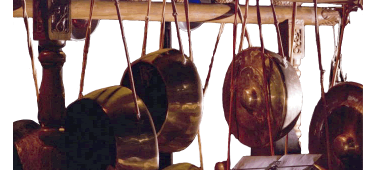The instrument
The heart of the gamelan is formed by the set of hanging gongs. The smaller ones are called kempul, ranging from 3 to high 2. The Utrecht gamelan has two intermediate gongs (gong suwukan) producing tones 1 and 2, and two low gongs (gong ageng), producing low 3 and 6. The gongs ageng hang on a separate rack behind the player
The gamelan gongs hang free swinging from a single horizontal beam, which is usually beautifullly ornamented with dual snakes, their tails intertwined in the middle and with crowned heads at the ends.
The gong sticks are big and heavy to move the mass of the instrument

Playing Technique
Because the gongs are not fixed they start dangling with quick play, eventually hitting each other if the part is to quick. This is one of several reasons why quick parts don’t work on the gongs. A second reason is that the gongs don’t fit in the available space if they all hang in one plane. They have to hang parallel to each other, making it very difficult to hit different gongs in quick succesion because the 2 beaters which are also quite heavy have to be moved in and out of the spaces between the gong.
The most important reason is finally that the gongs have a slow response because of their mass: they need time and considerable force to start and stop sounding, and when they are not damped the sound of the lowest gongs can easily last for tens of seconds.
Slendro & pelog
Alternative modern playing techniques
Besides regular play with soft and heavy beaters on the boss of the gongs, there is a possibility to use lighter and less soft mallets or wooden hammers, and to hit the gong on other places than the boss. This usually gives more percussive metallic noises and overtones without the fundamental bass tone. It is finally possible to place the gongs on the floor and play them as a percussion knstrument, giving a “boem’ sound without the normal long reverberation.

